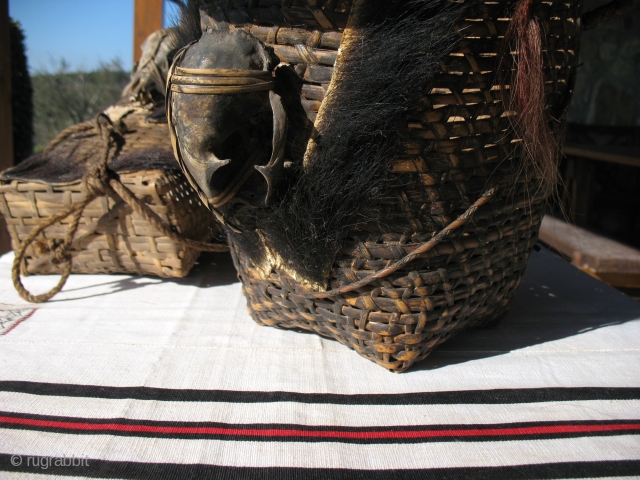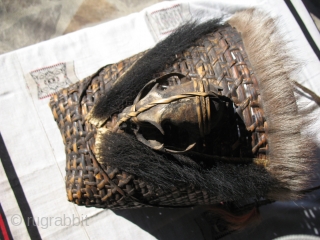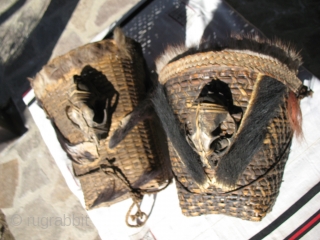Back
Two Naga head basket bought during last Naga festival held in north-western Myanmar mid January 2012.
Naga head basket are usually decorated with monkey or dog skulls and dyed goat hair.
These types of hats and baskets were worn by Naga warriors who participated in the act of head taking. Seen as essential for the rejuvenation of the community, human heads were taken from any non-village person found during excursions for the precious loot. Strong correlations exist in Naga culture between fertility, agriculture, the community’s health and well-being, and the bringing of a head into a village would ensure these benefits. http://bowersmuseum.blogspot.com/2006/11/objects-of-week-naga-head-taker...
The Naga people live in several groups in the region where Myanmar (Burma), China and India meet. Headhunting is said to be one reason the related Naga groups developed in isolation from one another.
NAGA
the original Naga culture was in the later stage of violent self destruction; had been significantly isolated from the rest of the world for decades (for geo-political reasons); and that no organization was actively researching, investigating or documenting aspects of this complex tribal culture before it vanished.
The various tribes known as the Nagas are to be found mostly in the north-eastern Indian state of Nagaland, but also in the neighboring states of Manipur to the south, Arunachal Pradesh to the north and Myanmar (Burma) to the east. These tribes inhabit a mountainous area of about 17,000 sq. kms. The Angami, Ao, Chakhesang, Chang, Khiamngan, Konyak, Lotha, Phom, Rengma, Sema, Sangtam, Tangkhul, Yimchunger and Zeliangrong are all Naga tribes that have historically been in contact with each other; sometimes trading, often at war. All Nagas distinguish themselves as people of the hills as opposed to people of the plains. They share a common ethnicity as well as certain basic social and cultural traits that group them together and set them apart from the people and culture of the plains. Yet they all speak mutually incomprehensible languages, harbor stereotyped prejudices about each other and each believes themselves to be superior to the others. Politically each tribe could virtually be a nation unto itself.
http://www.scifer.org/nagabackground.html
If you want to see some more pics: http://www.facebook.com/media/set/?set=a.10150697714074258.454864.358259...
See also my box masks: http://www.facebook.com/media/set/?set=a.475500409257.284224.35825986425...
price:
pls ask - one sold, one left
- Home
- Antique Rugs by Region
- Category
- Profiles
- Post Items Free
- Albums
- Benaki Museum of Islamic Art
- Budapest: Ottoman Carpets
- Gulbenkian Museum
- Islamic Carpets. Brooklyn
- Islamic Textiles. Brooklyn
- Konya Museum: Rugs
- MKG, Hamburg
- MMA: Caucasian Carpets
- MMA: Mamluk Carpets
- MMA: Mughal Indian Carpets
- MMA: Ottoman Carpets
- MMA: Safavid Persian Carpets
- MMA: Turkmen Rugs
- McCoy Jones Kilims
- Ottoman textiles. Met
- Philadelphia Museum
- Rugs and Carpets: Berlin
- Seljuqs at the Met
- TIEM, Istanbul: Carpets
- V&A: Classical Carpets
- Vakiflar Carpets: Istanbul
- Baluch Rugs: Indianapolis
- Gallery Exhibitions
- Jaf an Exhibition
- Alberto Levi Gallery
- Andean Textile
- Christie's London: 2016
- Francesca Galloway
- HALI at 40
- ICOC Washington, DC 2018
- Jajims of the Shahsavan
- London Islamic Week April, 2018
- Mongolian Felts
- Navajo Rugs: JB Moore
- Persian Piled Weavings
- SF Tribal & Textile Art Show 2020
- SF Tribal 2019
- Sotheby's: C. Alexander
- Turkish Prayer Rugs
- Turkmen Main Carpets ICOC 2007













